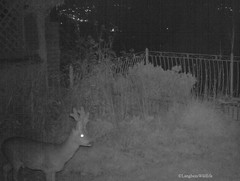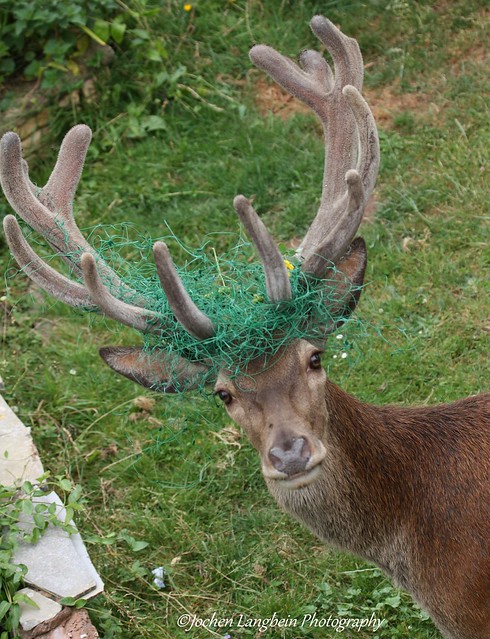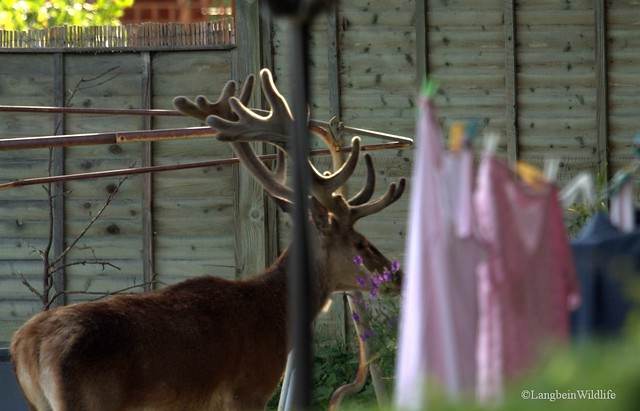As some red deer as well as fallow deer adapt to living amongst us in urban areas – can we too adapt to accommodate some of our largest terrestrial mammals living on our doorstep?
Some 40 years ago, when I began to undertake research into the behaviour and ecology of Britain’s deer, residents in the suburbs and in city centres were only slowly getting accustomed to the colonisation of their residential gardens and parks by ever increasing numbers of ‘Urban foxes’. Deer back then in the 1980s were still regarded by the majority of people as shy, elusive creatures who were rarely seen near built up areas unless enclosed in a deer park.
Red deer watch as diggers develop land for housing. Click youtube icon for full HD version
However since the 1960’s, the six species of deer living wild in Britain have greatly increased in numbers and distribution. At the same time, urban sprawl has expanded even further into areas of former deer habitat. Roe, our smallest native deer, weighing in at not much more than 20 to 25 kg, were the first to become a regular sight on the urban fringe, especially in southern England and the Scottish lowlands. At that time, while working within the ungulate research group at Southampton University, my colleagues and I were increasingly called upon to catch and remove roe deer trapped in local residential gardens.


Roe buck and Red Stag caught on camera in the same small Somerset garden
Tolerated and indeed enjoyed by many who like seeing deer in their gardens, media reports about urban roe – and increasingly also the smaller introduced muntjac deer – are unexceptional nowadays. While some relate to irate residents complaining about roe munching their roses and shrubs in gardens and city cemeteries, more often news stories concern deer in need of rescue after falling into steep sided canals, stuck in garden railings, or attacked by dogs. Higher numbers of deer-vehicle collisions have inevitably been another consequence, nowadays no longer just a rural issue, but equally frequent in peri-urban areas, where traffic volumes are often highest.
While the smaller deer species, and in some cases (see later below) also fallow deer have been living in suburban areas and some cities for many years now, how about our largest British wild land mammals – The Red deer ? Will they too start to appear in our suburbs and gardens? Well – in actual fact red deer are already established on the edge and indeed now within some towns in England.
Since the Middle Ages right up until the 1950’s the majestic red deer animals were largely restricted to remote upland areas, in particular the Scottish Highlands, south-west England and the Lake District, with just a few smaller scattered populations elsewhere. Several of the latter small pockets of feral red deer, usually derived from just a few animals that escaped from deer farms or where reintroduced deliberately by various ‘deer enthusiasts’ over the past 30 years, have expanded very significantly in the last decade, leading to increased reports of red deer sightings right across England. Standing at up to 140 cm at the shoulder, even red deer females commonly weigh in at near 100 kg, while fully grown stags may exceed over twice that weight.
A full grown wild red stag in Somerset visits one of his favourite secluded gardens
Over recent years I have been observing and filming a number of peri-urban herds of red deer in Staffordshire and Somerset, and urban fallow in Essex and Devon. These deer all, for a large part of the year, frequent residential gardens, derelict industrial sites, residential housing developments and even hospital ground.
My interest in urban deer was rekindled in 2014, when I spotted some red deer in residential gardens on the edge of Exmoor (a National Park where I had undertaken radio-tracking research of red deer 20 years earlier). Having set up a trail camera in a tiny private garden where the owners had reported seeing deer droppings, I was astonished during the first night to catch pictures not only a Roe buck, but a day later, a large red deer stag (photos above). Understandably – I was hooked! For the next four years in addition to the use of trail cams, I regularly ventured out to catalogue and film those red deer visiting a series of different gardens on the edge of Minehead. In observing the spread of deer into residential areas in England and Scotland, one of the things I have found most fascinating is that although red deer are perhaps the most recent species to do so, they appear to adapt and start to trust people possibly even more quickly and completely than other deer species.
 Red stag in spring joins squirrel in raiding wild bird feeder in Somerset
Red stag in spring joins squirrel in raiding wild bird feeder in Somerset
When I first observed red deer in gardens where the residents fed them, I thought they had learnt to recognise and trust particular individuals (and at times their dogs!), as at first they remained wary of me and others. As the wild red deer in several areas started to tolerate also me approaching them, sometimes as close as 8 metres (25ft) away, it became clear they more so sensed how I behave and react to their own movements than recognising me personally. Deer in most situations will seek to avoid being surprised by a potential threat close-by. This is due to an innate defence response against their past natural predators such as lynx or wolves. I soon adapted my behaviour so that when watching deer I now often find myself not crouching and hiding behind bushes, as a typical camouflage clad stalker or wildlife photographer might do. Instead, once within their normal flight distance, I may actually make a point of letting the deer know where I am, talking quietly to them and at times turning as if about to leave – though more often than not, I stay. 
Wild red deer waiting by school gates in Staffordshire
On one occasion when I was filming in a different area, a building site in Staffordshire, just as I thought I had got too close to a group of deer, I knelt down to adjust settings on my video camera. When I looked back up the deer had come even closer and several had started to sit down within 8 metres in front of me on a pile of wood shavings. This was clearly a regular favourite resting place for them. After sitting with them for some time, watching as they chewed the cud, I retreated slowly so I could film myself in front of the video camera, before leaving them in peace (see video at top of blog).
The film clips and photos below and above are all of entirely ‘wild’ red deer in England. They show how at ease the deer appear in their favourite garden haunts where they feel safe, or even on land being developed for housing that deer have used historically and still continue to do so whilst builders and noisy diggers go about their work.
It is evident that red deer, can and in some areas already have adapted to living in amongst our urban sprawl and industrial developments. In case of the deer in the clip above expansion of their population has in fact benefited and numbers increased over the past twenty years as brownfield sites on former coal mining land were reclaimed and developed into heath and scrub, while only some other parts are now developed for housing. However, whilst deer of all species have gradually adapted to living close to us, many people often remain blissfully unware of their nightly garden visitors until the deer become so bold as to stay during daylight as well.
Red deer spotted in the middle of a busy Staffordshire roundabout / Express & Star
A prime example of this a large population of fallow deer, that originated from Dagenham Park , a disbanded formerly fenced deer park (on the edge of London in the Borough of Havering, inside of the M25 orbital motorway. In the daytime initially most of these deer still tended to be seen in the open public parkland areas, and ventured into residential areas of Havering only at night ; however, in recent years increasingly the fallow settle on communal lawns surrounding housing developments, as in the picture and video below.
Plymouth is another area where fallow are now commonplace in residential areas, industrial estates and factory premises, which many residents tolerate despite them often eating their garden produce and flowers.
Inevitably there are consequences and challenges ahead, both for deer health and welfare on the one hand and public safety on the other. Deer in suburban areas are prone to getting wire or rope that has been left lying around, caught up in their antlers, to eating inappropriate low fibre feed (white bread / burgers!) given to them by well-meaning members of the public, as well as to eating discarded plastic bags or yoghurt containers and the like, or getting stuck in park railings. In a recent incident in Plymouth, two fallow bucks actually entered the corridors inside Derriford Hospital before eventually being escorted out !
Supplementary feeding of wild deer is generally best avoided in any case, not least where this may lead to large groups of deer congregating closely in one place, increasing the risk of picking up and onward transmission of parasites and diseases such as TB. For residents in areas with urban deer some further increase in deer damage to flowers and other unprotected garden produce as well as amenity tree planting is highly likely. A higher risk of road traffic collisions with deer in suburban areas may also be predicted throughout the UK, unless steps are taken to calm traffic and deter deer from crossing highest risk road sections, and if possible provide relatively safer wildlife crossing structures (underpasses) elsewhere. Interestingly, in Plymouth as also in Havering (London) the fallow deer have settled in particular in residential areas where speedhumps and traffic calming is already present, so that traffic speeds are mostly low; and whilst significant numbers of deer are hit by vehicles within Plymouth, the number of incidents is not nearly as high as might be expected with a population of likely >1000 urban deer! Nevertheless, vehicle collisions with larger deer can be particularly serious, although thankfully red deer do appear to have somewhat better road sense and awareness of traffic compared to their smaller more flighty cousins – fallow, roe and muntjac deer.


No prizes for guessing who has been at the strawberries!
As red deer as well as fallow spread into further peri-urban areas in future, I am keen to continue to track and film this developing issue in different parts of the country. I’ll be interested to hear from any readers who have red or fallow deer coming into their gardens and their experiences with them [To contact me please DM via Facebook, Twitter or email via LangbeinWildlife web-site, or use the reply link on this blog to comment]
Click youtube icon for full HD version
[Addendum – While the deer seen at a building site in the video clip at the top of this blog may appear to be restricted to living in and around built up areas, it is interesting to note that I filmed this second deer clip of a rutting stag and hinds dashing through water within just 1/2 a mile from that building development and saw the same stag at both sites.]






It’s hard to imagine seeing Red Deer roaming around town, in any context, but sadly to be expected with the numbers growing and the spread of people.
I watched 4-5 red deer browsing next to Taunton canal last week just below Heathfield school. I was no more than 10-15 metres from them but they weren’t bothered by my presence. I have a few photos.
One young stag and a few hinds. Initially I presumed someone had a small private herd but the lack of deer fencing and your article seem to suggest otherwise.
Bizarre given that I have only ever had fleeting or distant views of wild red deer. I’m programmed to presume that only a visit to the Quantocks or Exmoor will allow you to see them in the wild.
I have mixed emotions about them straying so close to our towns. It’s great for us but it feels like they’ve lost a little of their mystery and it can only be a matter of time before the traffic claims one.
Thanks very much Simon, and excuse slow reply. Really interested to hear this information, even though agree entirely that red deer coming so close to major towns does raise concerns, not least for them. Red deer have interestingly been turning up at times both north and south of the centre, though expect they are different groups.